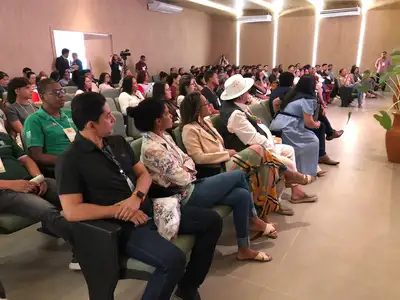Fapespa delivers unprecedented report revealing the economic impact of the bioeconomy in Pará
Document released during COP 30 shows that the sector generated R$ 13.5 billion in 2021 and details the challenges and potential of Amazonian sociobiodiversity
During the 30th United Nations Conference on Climate Change (COP 30), held in Belém, the Amazon Foundation for Support of Studies and Research (Fapespa) delivered, on this Tuesday (11), an unprecedented technical report that maps the economic dimension of the bioeconomy in Pará. The study indicates that the sector generated R$ 13.5 billion in 2021, reinforcing its strategic role for the regional and sustainable development of the Amazon.
The document was produced within the framework of the Pará Network of Studies on Regional Accounts and Bioeconomy, coordinated by Fapespa, in partnership with the Federal University of Pará (UFPA), the Federal University of Western Pará (Ufopa), and the Federal University of Southern and Southeastern Pará (Unifesspa). The initiative uses internationally recognized methodologies, such as those from the United Nations (UN) and the Brazilian Institute of Geography and Statistics (IBGE), to accurately estimate the value and structure of production chains based on sociobiodiversity.
Manioc, açaí, cupuaçu, cocoa, fishing and aquaculture, honey, and oilseeds such as andiroba, copaíba, and palm oil are among the main chains analyzed. The survey demonstrates that for every R$ 1 invested in the bioeconomy, R$ 1.13 is generated in Gross Domestic Product (GDP), R$ 0.19 in wage mass, and R$ 0.06 in taxes.
Informality and inequality in production chains
One of the main findings of the study is the high informality of essential chains. The production of manioc, for example, has a Gross Value of Production (VBP) estimated at R$ 7 billion, but only R$ 10 million is formally registered. This is largely due to processing done in community flour houses, outside the financial system and public policies.
The report also highlights the inequality in income distribution. In the case of Brazil nuts, only 2.94% of the final value goes to extractivists, while the industry concentrates more than 95% of the wealth. On the other hand, chains organized in cooperatives, such as those for andiroba and copaíba oils, manage to retain between 19% and 32% of the total value, showing the importance of community organization.
More structured chains and trade flows
The study identified that chains such as fishing and aquaculture have a higher degree of formalization, with commercialization to states like São Paulo, Goiás, and the Federal District, in addition to exports. Pará cocoa is predominantly channeled to Bahia, the main national chocolate hub.
The analysis, based on data from Electronic Invoices, allows mapping trade flows and supporting policies for value aggregation within the Pará territory.
Impacts of climate change
The research also points to the already visible effects of the climate crisis on agricultural and extractive production. In regions like Marabá and São Domingos do Araguaia, fires and severe droughts have destroyed babassu and Brazil nut groves. In western Pará, there are reports of a decline in the flowering of Brazil nut trees and losses in essential crops such as beans, bananas, and cassava.
Based on maps developed from the AdaptaBrasil platform, the Network identified areas of high vulnerability to drought and low adaptive capacity, reinforcing the need for targeted actions for climate adaptation.
Importance of data for public policy formulation
“What we have now is a detailed portrait of the bioeconomy in Pará, which allows us to formulate more efficient public policies. One thing is to propose solutions without understanding the complexity of the sector; another is to have data that proves its robustness and economic importance,” highlighted Daniel Silva, professor at the Faculty of Economic Sciences of Unifesspa, during the report presentation.
For Professor Luiz Gonzaga Feijão from Ufopa, “the bioeconomy of sociobiodiversity depends on a healthy and resilient biome. We produce with the forest, not against it. Therefore, data is essential to guide investments and public policies.”
The report proposes measures such as:
- Creation of specific policies for the informal economy;
- Strengthening local cooperatives and associations;
- Investment in climate adaptation in more vulnerable areas;
- Encouragement of industrialization and value aggregation within the State.
The Bioeconomy Network also announced that in the coming months it will launch a new research agenda on topics such as forest restoration, territorial conflicts, female leadership in production chains, and the development of advanced indicators to measure the forest economy.
Cooperation for sustainable development
The cooperation between Fapespa and the Pará universities establishes integrated programs of research, teaching, and extension, focusing on knowledge generation, data sharing, and the development of evidence-based public policies.
“The Bioeconomy Network organized by Fapespa represents a fundamental step to measure the Amazonian bioeconomy in an innovative way. These studies help consolidate existing practices and propose new approaches that can guide both the public and private sectors towards sustainable development,” explained Atyliana Dias, director of Statistics, Technology, and Information Management at Fapespa.

















